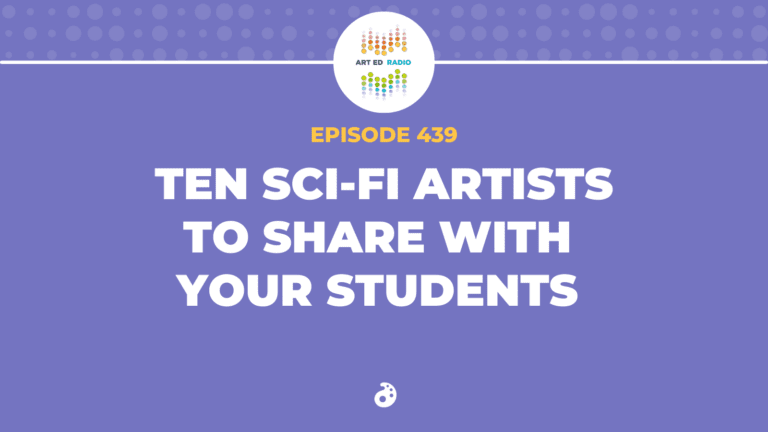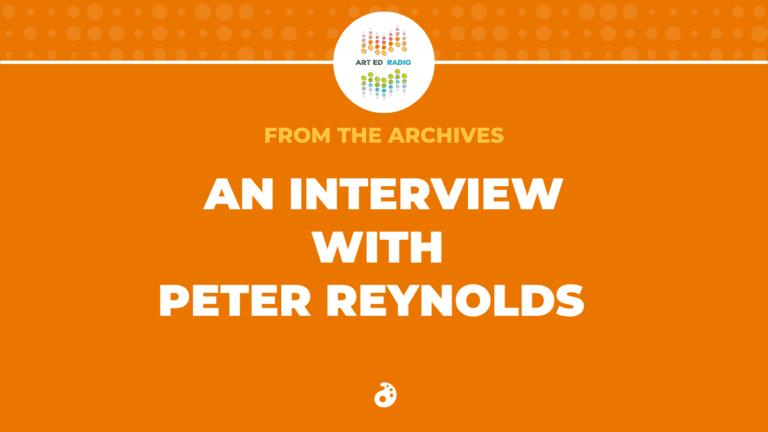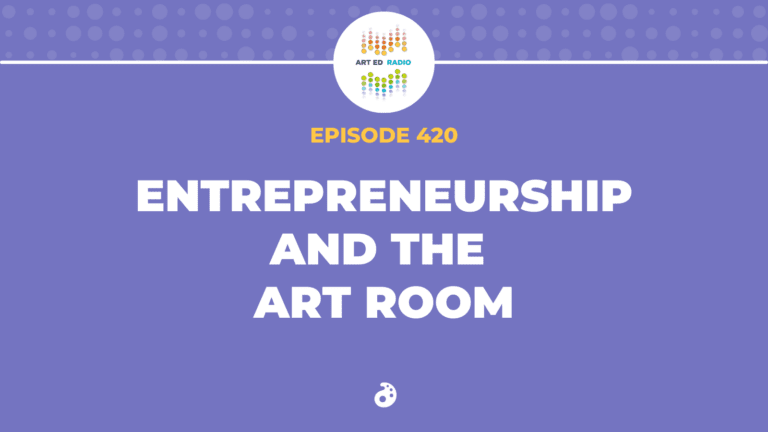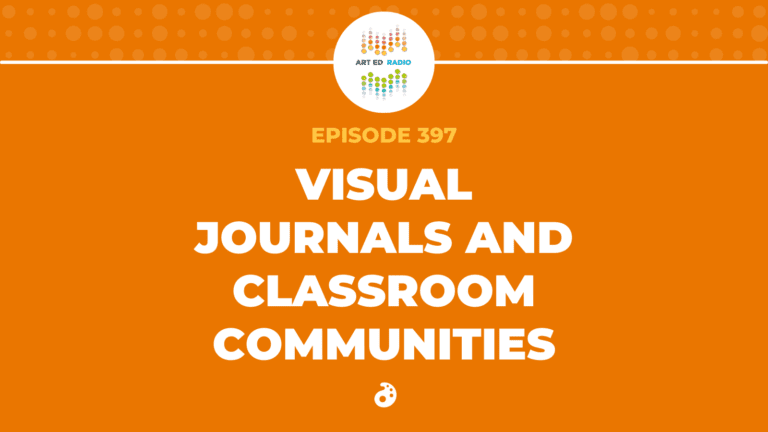Social and emotional learning is a topic that is not discussed enough, and it is important that all art teachers start to see how they can begin connecting their art lessons to social and emotional learning. In this episode, Tim welcomes Elizabeth Peterson from The Inspired Classroom to talk about these topics and many more. Listen as they discuss Arts Integration, caring for and connecting with our kids, and why every teacher needs to always remain open-minded. Full episode transcript below.
Resources and Links
- The Inspired Classroom Website
- Social Emotional Learning Ideas
- Social-Emotional Artistic Learning (SEAL)
- What it Means to be a SEAL Teacher
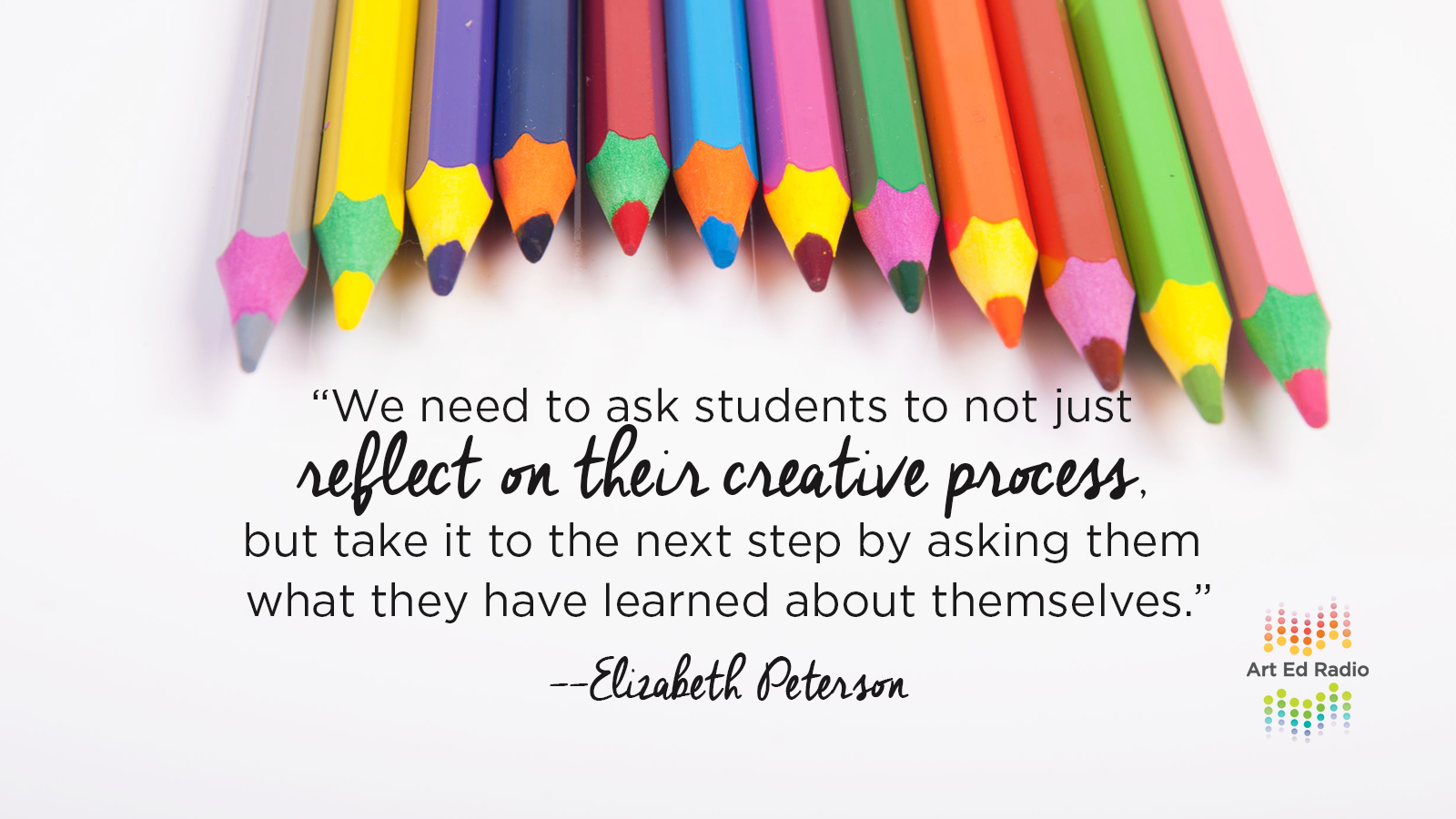
Transcript
Tim: Welcome to Art Ed Radio, the podcast for our teachers. This show is produced by the Art of Education, and I’m your host Tim Bogatz. I’ve been wanting to do an episode for a while on social and emotional learning in the art room, and I think that the topic is something that we don’t discuss enough as art teachers but it’s something that can pay an incredible dividend for our students. Honestly, it’s something that fits in seamlessly with what we already do in the art room. Teaching kids things like self-awareness, especially about their own thoughts and their own emotions is honestly essential for our kids with success. When we can tie that into what they’re trying to accomplish, what they’re trying to learn, they could be more in touch with their own learning and their own goals. Teaching them empathy I think is vital as well, and this is where art comes in because there is nothing better than art when it comes to helping kids understand, and helping them feel compassion, and empathize with people from different backgrounds and different cultures as we try to recognize their stories and recognize what is being told to us.
All of that is going to be part of our discussion today. My guest is Elizabeth Peterson, a teacher and an author who knows a lot about these topics. Her website The Inspired Classroom is a wealth of information, and she has recently started researching and planning on the best ways to incorporate art in the social and emotional learning. She calls it Social and Emotional Artistic Learning or SEAL for short. I want to ask her about ways for us to better understand these concepts, and ways that we can bring these ideas into our own classrooms. As I said, she has so much to share and so many great ideas to cover that I think we’re going to need to give this discussion a lot of time. Let’s go ahead and bring her on right now. Elizabeth Peterson is joining me now, Elizabeth how are you today?
Elizabeth: I’m doing fine thank you, so good to be here Tim.
Tim: All right, well thanks for joining me. I appreciate it. We have a lot to talk about-
Elizabeth: Yes we do.
Tim: … but first of all, I was hoping you can tell us a little bit about your website. Can you just give us an explanation of The Inspired Classroom, and I guess what inspired you to start the website?
Elizabeth: Excellent, yeah. First I got to say that it’s really exciting to be here on AOE, I’ve been watching Jessica grow this from when she first started blogging, and so I’m really excited to come back as a podcaster. I blogged for her-
Tim: Wow, that’s awesome.
Elizabeth: … a while back and it was really great, so I love what she’s doing for art teachers. For The Inspired Classroom, for me, it was about the problem that we educators have been facing for sadly about two decades or so with standardized testing coming into play, and the almost backwards path from teachers being able to plan creative and interesting units, to in some cases even following scripts. Do you know, that’s not why most people go into education? They want to change lives, they want to inspire their students. My background is in music and arts integration, and my goal has always been to find the time to insert great creative experiences for my students regardless of what other content I needed to be teaching. I really work hard to make that time for my students, and for me, it’s important for me too. You know?
Tim: Yes.
Elizabeth: I wanted to share those experiences with other teachers as I grew over the years of teaching that I’ve had, and I wanted to empower other teachers to allow them to have an inspired classroom. The website itself actually started as a way for me to promote my first book, which is Inspired By Listening, which is a resource for integrating musical listening experiences into the classroom. It naturally bloomed into a blog, where I could start to really formulate my philosophies on teaching and learning, and it’s really been wonderful to be able to grow it into the great resource that it is now for teachers who want to find that inspiration for their teaching.
Tim: I think that’s a lot of really good resources there, and I think definitely-
Elizabeth: Thank you.
Tim: … something that people need to check out, but I know that another thing that you are really interested in is the idea of social and emotional artistic learning or the acronym SEAL. Can you just explain what that is, why it goes well with the arts? And most importantly why you think it’s so important?
Elizabeth: Oh yes, of course. SEAL is very exciting because it addresses this new struggle that so many of us teachers are facing right now. If you’re like me, you have classes of students who are dealing with anxiety, and stress, and overwhelm, and pressure, they may be coming from a dysfunctional home life, coming to school hungry and dirty. I have one student that literally rives in the pain of anxiety at the mention of a writing assignment, so kids just are so emotionally distressed. Often you find students who really don’t understand even how to get along with others, it’s a real big problem and it’s not just in one facet of education, it’s across the board. It’s art teachers, gen ed teachers, it’s high school, elementary, middle. It really doesn’t matter what you’re teaching, we’re really all in the same boat here. Administrators are feeling it too, even society I think is feeling it but that’s a whole another conversations. We’re all faced with the same issue whether we’re dealing with children or adolescents, or young adults coming to us with so many different social-emotional issues. Then comes the question, “How do we address this?”
Well, for any teacher who really understands the power of art and what it can do for learning, the answer is SEAL. SEAL as you said stands for Social Emotional Artistic Learning. It’s really the newest branch of art integration, and I’m really proud to say it’s something I’ve been working on for a few years now. SEAL came out naturally as my district that I work in … I’m in Amesbury, Massachusetts, my district started to see that there was a real need for social-emotional learning in our schools, and so they started to talk more about SEL. As the administration was explaining casel SEL wheel, I was like, “Well, duh we can teach that through art. Well, duh we can teach that through art. You want students to know more about themselves, well, have them create some art. You want students to build a relationship with each other, well let’s go make some music together, or let’s create something, go dancing, work on some theater pieces together.” Then a little while later I was struggling for a new focus of my newly developing winter retreat, at that point, I had been organizing summer teacher retreats for about six years at that point and I really wanted to define a new focus for this winter one.
Then it dawned on me teaching social-emotional learning through the arts, and eventually played around with the letters, and SEAL emerged. The arts are really the best way, the most natural way to develop those social-emotional skills. It’s really important that all art teachers start to see how they can really start connecting their art lessons to social-emotional learning because so much good can come out of this explicit teaching of art with SEL.
Tim: Okay. I want to dive into that, that’s a really good point. I want to ask you a little bit more if teachers are looking for ways to bring more of the social-emotional learning into what they’re doing, can you maybe share some easy ways for people to understand social and emotional learning? What is it, the background of it, and maybe just some simple suggestions on how to bring it into your classroom?
Elizabeth: Yeah, absolutely. Most of SEAL is framed around casel’s SEL wheel, and castle is C-A-S-E-L. It includes five competencies, they are; self-awareness, self-management, social awareness, relationship skills, and responsible decision making. I think the biggest shift that visual arts teachers and all teachers really can make is to bring these competencies to the students’ attention, we often trust that the creative process and we trust that students will naturally start to learn about themselves and the world around them through their art, but I’ve found it makes a huge difference when we really take the time to point it out. For example, it could be as simple as if a student is creating a sculptor from clay and you notice a difference in his or her focus. Just going over and mentioning that, and even talking about it for a moment with the student, you know say you noticed that he’s more calm and his body is more relaxed and that he has a pleasant expression on his face, ask him how he feels, and even probe a little bit to see if he can start to identify his emotions and what about using the clay makes him feel that way?
Then pointing out that he can use clay to help himself actually self-manage his emotions, so you can even suggest that he use clay or dough to help him when he gets all hyped up. It’s really not about keeping things secret, it’s more about acknowledging a student’s needs and their strengths according to the social-emotional development that they’re going through so that they can grow. That’s why there should be a focus on that explicit teaching like, tell stories about artists who struggle and how they may have dealt with or even conquered some of those struggles through their art, and reflection. Asking students not just to reflect on their creative process while making something in class, but also taking it to the next level by asking them what they have learned about themselves, or sharing products with each other in class, and then asking students what they’ve learned about their peers. Guiding these kinds of conversations in the art room is so powerful for their social-emotional learning.
Tim: I think that that’s really important. I was thinking of the word that you mentioned, just making that learning explicit because I think so many times we just assume that our kids are thinking about these things, and that’s not an assumption we can make and I like the idea of bringing that to the forefront. As you said, we don’t want to keep these things secret, you really want kids to think about what they’re learning, and to really support-
Elizabeth: Yeah, and starting to really use those words, “How are you self-managing? What are your emotions right now? Tell me a little bit about that.” It’s really important.
Tim: Yeah, that’s really cool. Now I wanted to ask you to … this is just something that I really like for my website also, you talk about the three Cs; caring, connecting, and creating. I think that’s something that we all try to do in our art rooms, but again you’re making explicit here talking directly about how we can do that. Can you just talk a little bit about why you think art is the best place or at least the right place to teach those ideas?
Elizabeth: Sure, yeah. SEAL is first and foremost really all about a mind shift for teachers as well as methods and ideas for use, but I call it becoming a real SEAL teacher. We’ve heard a lot lately about how teachers show they care for their students, like have you seen some of those videos of teachers who greet theirs at the door?
Tim: Yes, yes.
Elizabeth: And there’s one where this teacher has a unique handshake for every kid, it’s pretty cool. That kind of connecting with each student is so important for our kids these days, they need that. It doesn’t really matter if the kid comes from a dysfunctional family or is at risk, or even if they’re well off, or they’re just like a stellar student, all kids need to connect with their teachers. Of course, it may seem cliché to say this, but it’s so true and we all know it, that for some kids the only place they may feel that connection is in the art room. So caring and connecting is also about making sure you go around and actually check in on every student, every single class. This is hard, this is not easy. There are some kids that take up all your time, and so it takes discipline and practice to do this. Even me and my general ed classroom … I teach fourth grade right now, where I have the kids, same kids all day. Sometimes I get to the afternoon and I realize I haven’t even had a short conversation with a couple of my kids, you know?
Tim: Yeah.
Elizabeth: They melt into the background, or they’re just doing so well that I don’t think they really need me. But I realize that they all really do need that connection, so when your art students are working on their projects it’s really important to touch base with all of them, or even if it’s during setup or clean up. Kids really notice those things, so taking a step back every once in a while and saying, “I think I really … for some reason I’m ignoring Johnny, and I don’t even know why but I just need to make sure I go over there and I start talking to him or noticing something about him.” It’s hard and it really does take some practice. Then, of course, there’s the creative part of it, and of course, that probably seems like a given within the art room, right? But that’s the part that really differentiates any good SEL teacher with a SEAL teacher, that creative part. For art teachers it can even have a different layer, you already are allowing students to create, but it’s awesome when you can take it a little bit further and notice how kids are creative, where their talents really lie, where they need help.
Then you can give it to them, where you can challenge them to use their creativity to become better people. It might be how can they use their artwork to make a statement about something they believe in, and then go do something about it. That’s part of social awareness, and responsible decision making, or how they can use their knowledge of an artistic technique to help build relationships with another student. In other words, how can a student go help another student? That’s how they’re practicing empathy and then after they’ve had a chance to help another student, do a little short followup with them, and that’s really important too. That’s where you can ask the student how it made them feel to help someone and to ask them what they learned about that person when they helped that person, or what they learned about themselves. It all takes that different layer in the art room above and beyond just the basic, “Let’s make sure there’s time to create, let’s take it a step further and see how that creation can make us better people.”
Tim: I really like all of these specific examples of what we should be talking about with our kids, I think that’s going to be really helpful. One other thing that I wanted to talk to you about, just another idea that I really like was your idea of studio days in the classroom. Can you explain that concept for everybody and talk a little bit about the book you’ve written?
Elizabeth: Sure, thank you. I love the idea of studio days because it helps to solve the problem of time. Nobody likes it when you’re in the middle of a project, and you have to stop and transition to a completely different thing. Studio days is all about really respecting the creative process, and students often don’t get a chance to work through a project from start to finish and so studio days allows for this. I felt like since I do have my for longer periods in the day that I could do this. There are ways to make this work for our teachers as well. I realize there’s a huge issue with timing, you might only see your kids for an hour or even just 45 minutes a week. I mean I remember that when I was teaching music, I was a middle school music teacher for about seven years, and having the kids for an hour a week it was just so choppy. Hopefully, you can have great colleagues that may want to collaborate with you, so that maybe they’re working in their classroom and you can come in and really contribute to the whole project, or even kind of move around, or combine times, or switch times around to mess with the schedule a little bit.
So it’s still beneficial for the students and for the teachers, I’m a huge proponent for teachers as well. Collaborating can really be, and really should be fun for the teachers as well. So there’s always that … just ask and see if there’s a way to create this time for studio days. The formula for a studio day is to introduce up our project, and it could be visual art, photography movement. In the book, I have about 10 different lessons that touch on different art forms, and then there’s ample time given to the students to actually go through the whole creative process. For example, there’s a photography lesson in there, where they are taking photos of flowers and plants outside. We discuss some basics of framing the image, and the rule of thirds, and getting up close to your subject as opposed to zooming in. Then students go out and experiment with taking photos, and just giving them so much time to take some photos and choose what they want to keep, and print out the ones that they want to use for their final product.
The final part of the studio day is a reflection, and this is really the most important where they need to think about themselves. Every reflection time ends the same way asking, “What did you learn about yourself as a learner?” And it’s amazing how the students will actually discover things about themselves when you ask them directly. So studio day, it’s really such a natural application to SEAl. Students work through the creative process, and then they reflect on it, and they discover so many things about themselves.
Tim: That’s really well said, and I think encompasses a lot of the goals that we have as teachers and what we want kids to get out of our classrooms. I think that’s a really good approach to that. But-
Elizabeth: Thank you.
Tim: … unfortunately, it’s time for us to wrap things up, so-
Elizabeth: Sure.
Tim: … I just have one last question, we have all of these ideas, all of these concepts that we’ve covered, but if you can simplify things or just pair it down to just a little piece of advice, what do you think kids need most from us as teachers to help their social-emotional artistic learning?
Elizabeth: I think the best thing for me to offer here is to say that we need teachers to stay open-minded. I see a lot of teachers who don’t fully appreciate their students for what they see in front of them. It’s really human nature, it really is. We make judgments too quickly. I’m guilty of this too sometimes so please don’t think I think I’m perfect, we’re in this together, we all can use some tuning up. We need to remember that all these kids in front of us, they all have something to offer and we could be just the teacher to help them find their thing, and that’s really the key to being a great SEAL teacher.
Tim: I love that, I love that idea because so many kids to find what they’re looking for in the art room so that’s really well said.
Elizabeth: Yes, they do.
Tim: I think probably a good place for us to wrap it up, so Elizabeth thank you so much for joining me today. It’s been awesome to talk to you, and I really appreciate you coming on.
Elizabeth: Thank you very much, I have really enjoyed talking to you about all these topics.
Tim: As I said in the introduction, social and emotional learning is a topic that I don’t think we talk about enough and that’s why I appreciate Elizabeth taking some time to discuss that with me. She not only has a great way of helping us understand what social and emotional artistic learning is, but she also has a great way of helping us understand its importance as well. It can make a huge difference in our kids’ lives, and I think the more we implement it the better off our classrooms are going to be. If you’re interested in social and emotional learning, I want to encourage you to also take a look at his year’s ART Ed Now Conference. It’s taking place on February 2nd this year, the first Saturday in February. We’ll have a presentation on art therapy, a presentation on social and emotional learning in the art room, and a really wide variety of other topics. It is an awesome day of professional development. You can see all of the presentations we’ve released, see what the conference is all about at artednow.com make sure you check that out soon. All right, that is all for us today.
Again thank Elizabeth for coming on and sharing her understanding and her insights. Make sure you check out Inspired Classroom and make sure you check out all of her work on SEAL. I really appreciate her sharing all of that with us, and I hope you appreciated it as well. Art Ed Radio is produced by the Art of Education with audio engineering from Michael Crocker, thank you as always for listening. Just two more episodes until our holiday break, and we will make sure they are good ones. We’ll talk to you soon.
Magazine articles and podcasts are opinions of professional education contributors and do not necessarily represent the position of the Art of Education University (AOEU) or its academic offerings. Contributors use terms in the way they are most often talked about in the scope of their educational experiences.
